For many years battery chargers were simple beasts; a heavy transformer to drop the line voltage and a rectifier to change AC to DC made up the bulk of components. Some added a relay to turn on the charger when the voltage fell. Also, some chargers served as battery boosters with a temporary hit of 50 amps or so to nudge a discharged battery into a start.
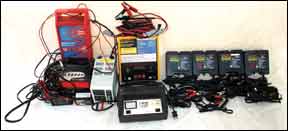
These chargers did a lousy job in terms of battery life and fully charging the battery to its potential (pun intended). Both the RV and boating industries were probably the big drivers in the development of sophisticated, computer-chip-controlled, multi-stage chargers, especially for deep cycle batteries.
It took a number of years for these sophisticated chargers to evolve and reach the aviation arena and our 2007 report in Aviation Consumer showed the state of the art then available—the BatteryMINDer from VDC Electronics expressly designed for aviation batteries. What has changed since 2007 is further sophistication, charging profile specialization and simplification of user requirements to one button. These charger products are approved by battery makers Concorde, Gill and Odyssey.
Aviation Specific
What we mean by aviation-specific chargers has nothing to do with FAA/PMA certification, since that is not required, but rather it is a custom charging profile in both current and voltage that is designed for optimum charge and battery life. This profile is enhanced via an included battery sensor attached to the battery terminal to adjust for battery temperature. Unfortunately, the word has not gotten out on the significance of an aviation specific charger over a conventional automotive charger—even sophisticated chargers designed for the automotive, marine or RV markets are not satisfactory for aviation from our testing results. Automotive type chargers that we have repeatedly tested have either too high a peak voltage or too high a trickle voltage or excess current for optimal life of aviation batteries—or all three. And now that the majority of aviation batteries in use are of the sealed AGM type, proper charging is more critical than ever. According to our recent AVWeb reader survey of 723 owners, only 37 percent of owners use chargers, and of those 37 percent, only six percent use an aviation-specific charger. Such low charger utilization helps account for the alarming failure rates (failed in under 24 months) that were reported with Gill batteries (29.6 percent) and Concorde (7.6 percent). It’s interesting to note that in the reader remarks section of our survey, there were rave reviews of improved battery life when they switched to a VDC BatteryMINDer aviation charger.
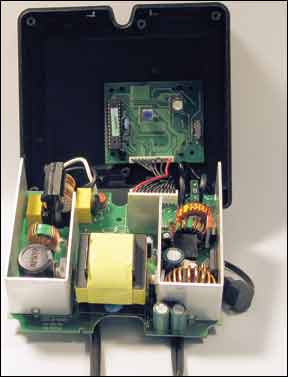
A Death Gene?
One reader described aircraft batteries as having a three-year death gene. It’s certainly true that two to three years on average based on our survey is what most consumers get for aircraft battery life, or at least a battery that will still pass a capacity test. Gill recommends a three-year change-out interval.
It’s certainly possible to keep a battery in service that is we’ll past its ability to keep minimal required electronics running for 30 minutes if the alternator should fail as specified per FAR 23.1353. Even a badly sulfated, low capacity battery will start an engine in good shape in warm weather, but not much else. The short life of aircraft batteries is attributable to several factors that can now be owner controlled to gain greater service life.
The first problem is that aircraft batteries are marginally sized for the task in order to keep battery weight down. They have about two-thirds the capacity of an automotive battery, yet have to start up to a 540-cubic-inch engine with mud-thick oil. So, by design, much more is demanded of aircraft batteries.
And instead of a hot spark that a coil produces with the aid of computer-controlled automotive engine timing, aircraft depend on primitive (but reliable) magnetos and equally primitive ways to retard the timing for starting. This means a weaker spark and often prolonged starts, resulting in greater discharge, which over time also takes a toll on battery life. Most cars move daily or at least weekly, where aircraft may go for weeks between starts. Unfortunately, batteries self-discharge daily at a rate of between one and two percent for flooded batteries, but AGMs much less so, by one third that rate.
A partially discharged battery sulfates or forms a resistive film on the plates that reduces the capacity, starting current and life of the battery—the longer and deeper the discharge, the more stubborn and deep the sulfation film that forms. This sulfation eventually becomes permanent and not recoverable by any means or chargers we have tested, except the BatteryMINDer® with less severe cases of sulfation. Month-long inactive intervals can cause permanent battery damage.
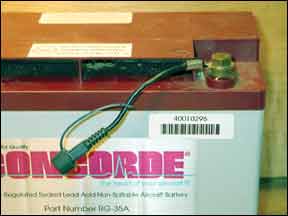
Sulfation leads to premature battery death—thus the three-year death gene is based on sulfation from a lack of proper battery maintenance. The other factor that leads to sulfation is heat exposure. The warmer the temperature, the faster the self-discharge and the faster the sulfation. Mistreat the battery and suddenly you are at two or three-year life spans—or less.
No Good Deed
Unfortunately, even well-intentioned owners can do as much harm as good when they place their battery on some automotive-type chargers. The harm starts with the battery being charged initially with a high current (10 amps or greater) automotive charger, overheating the plates and permanently warping them.
But even a low current automotive charger can do harm if the float voltage is set too high. Batteries have an optimal charge rate based on their amp-hour capacity, and 2 to 4 amps is more than adequate for most GA lead-acid batteries of 24 or 12 volts, but the voltage must be correct also.
It is possible to use up to 8 amps charging a 12-volt battery if you use “soft start” technology, which, along with a temperature probe, is how the BatteryMINDer® avoids overheating the battery. This system controls the voltage and current while quickly charging as fast as the battery safely allows.
Electrolyte bubbling out of the filler cap openings of a flooded battery during a charge means too much charge current/voltage and permanent damage, reducing capacity and life. Ironically, such high current charges do not fully charge the battery either, and that’s one of the reasons that multi-stage chargers were developed.
Leaving the battery on an automotive charger does assure the battery will be sufficiently charged to start the airplane, but it doesn’t do much for the health of the battery. Both the primitive or multi-stage automotive chargers (at least every one of the dozen we have ever tested) slowly cook the battery and boil away the electrolyte while it sits plugged in during the so-called “float” or trickle charge. The reason is that automotive “float” or trickle charge voltage is nearly universally set too high for aircraft batteries and does not adjust adequately or at all to temperature changes as it must to do a proper job. In one case, a very popular automotive multi-stage charger, the Battery Tender brand, recommends against its use for aircraft batteries, as does Concorde on their Web site. It is a good automotive charger, however.
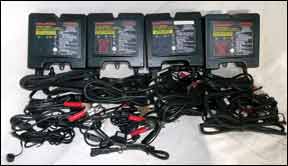
Some of this sulfation harm could be reversed if the owner was diligent about keeping a flooded battery filled to the split ring. But most times water is added (and it should be distilled water) we’ll after the harm was done and plates were exposed to air for some time, which promotes permanent sulfation.
So, due to marginal battery capacity, and no maintenance, combined with long-term sitting, which causes self-discharge and resultant sulfation or the use of automotive type chargers, which can cause damage, we find the basis for dramatically shorter aircraft battery life.
AGM sealed batteries are now the majority installed in the fleet, and these batteries cannot recover from an overvoltage and loss of electrolyte. One big advantage of AGM batteries is that their lower self-discharge rate is more resistant to sulfation when ignored and left sitting.
The downside is their vulnerability to overcharging. AGMs can take huge charging currents like a sponge without damage as long as the voltage is not excessive. For the same reason (ultra-low internal resistance) they can put out higher cranking current than a flooded counterpart.
In recent years, one battery charger manufacturer, particularly, has made it their goal to make aircraft batteries last a long time and remain fully charged between flights. That company is VDC electronics, maker of the BatteryMINDer (not Battery Tender) line of chargers. VDC has even coordinated with both Concorde and Gill to design optimal charging profiles for all aircraft lead-acid batteries of all types in 12 and 24 volts, AGM or flooded—even the Odyssey battery.
In the case of Gill, they have specially optimized a charger profile for the expensive LT series AGM battery line. Gill sells its own branded battery charger, and it’s a good one, but is so expensive as to be prohibitive other than for shops. Gill does approve of VDC chargers as does Concorde.
And as mentioned, the BatteryMINDer “soft start” feature senses a badly discharged or sulfated battery and holds the charge current down until the battery has taken on sufficient charge to safely turn up the current. This avoids overheating and warped plates or outgassing.
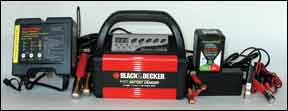
We Test the Theory
Testing batteries is something we are at constantly as we test for sulfation rates, recovery and other issues that only can be performed over time. For this specific test, we used a number of automotive type chargers that have been sent to us for evaluation or purchased to compare to the latest VDC line of chargers, which use a temperature probe to ensure maximal current for quick charges.
We used two-year-old intentionally abused Concorde AGM and flooded 12- and 24-volt batteries for the tests to see if any charger recognized/removed sulfation we knew was present.
VDC has evolutionarily changed their BatteryMINDer line over the years, continuing to optimize and simplify the design as we’ll as add products like their charger/25 amp power supply combo, model 28252-AA. The four models we tested are in the popular 12248-AA (12-volt) and 24041-AA (24-volt) AA S2 and S3 series. We have previously tested their solar panels and combination aviation charger/25 amp power supply model 28252-AA for reports in Light Plane Maintenance magazine.
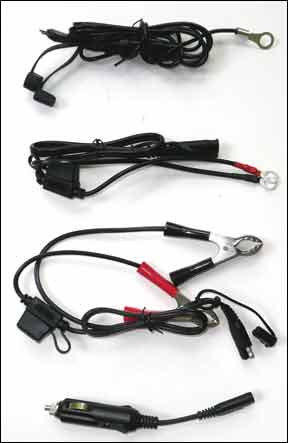
Older VDC models had multiple user settings for charge current and battery type, whereas the latest model has internalized the settings to automatically sense the optimal charge current and recognize the battery type. It also has an automatic desulfating cycle, which cannot rescue all sulfated batteries, but can keep one from sulfating in the first place as we’ll as recover a battery from a lesser degree of sulfation. It will tell you if the battery is too far gone for satisfactory recovery.
In fact, the BatteryMINDer flagged our test batteries after all automotive charger had indicated they were OK and fully charged. We confirmed sulfation via a capacity test, but used the BatteryMINDer to get back most of the lost capacity by following the instructions in the comprehensive owner manual, something none of the other chargers had.
For consistency and a constant baseline to get accurate charge times, each battery was discharged via a constant 5 or 10 amp draw (depending on whether it was a 12- or 24-volt battery) to a point considered nearly discharged at 12.3/24.6 resting open circuit volts. Each charger was cycled twice. If any variation in the recharge times were noted, then a third run was made. We noted charge times, charge current maximums and maximum charge voltage, as we’ll as float voltage in both 70 degrees F and 100 degrees F environments. The VDC chargers have a nice feature of extra charging capacity (up to 8 amps in 12-volt models), which allows you to charge several batteries at the same time, while avoiding harming a single battery. The computer in the charger senses if excess temperature is rising in the battery and lowers the charge current. (See the comprehensive manual for multi-battery charging.)
In terms of charge voltage , we were looking for a maximum of 14.4/28.8 volts (optimum volts were 14.1/28.2 at 70 to 80 degrees F), and 2-4 amps average charge current. Current varies as the battery charges in a constant-voltage battery charger, which is by far the most prevalent design on the market. Any higher voltage and the battery slowly overheats and loses electrolyte, reducing capacity and life. See the chart for temperature/maximum charge voltage ratios. As it gets warmer, charge voltages must go down. If it gets colder, they go up.
An excessively high maximum charge voltage, over 14.4/28.8 volts at 80 degrees F and the battery again loses electrolyte, overheats, and plates can warp. Sealed batteries can vent and lose capacity, which is unrecoverable. Note that a few tenths of a volt can make all the difference in the effectiveness as we’ll as avoiding battery damage, and the correct charge voltage varies with the ambient temperature by as much as 1.3 volts in a 12-volt charger (see the table).
The results mirrored our past tests, with the VDC chargers being spot-on specification and adjusted for the 30-degree difference in the two test temperatures. The automotive type chargers were all various types, mostly computer chip-controlled chargers of varying sophistication, and none of them adjusted temperatures. See the table for results.
If you must use an automotive charger, check the voltages with a good digital meter as we have outlined. If they exceed these voltages (especially at float), you are doing more long-term harm than good, in our opinion.
Our Winner
There really is no contest; the VDC BatteryMINDer aviation chargers win in all departments, except price. But for that price you get what you pay for. You get an aviation-specific, simple-to-use, full-featured, temperature-compensated, powerful charger capable of charging up to three batteries at once, or one battery much faster and safer than any other charger tested. About the only other time you will find a temperature probe other than the BatteryMINDer is with costly, deep-cycle marine/RV chargers costing many hundreds of dollars.
There are two different BatteryMINDer charging profiles for aircraft batteries (S2 and S3) and two different voltages (12 and 24), so read the VDC aviation Web page section carefully or ask them for help, but the Web site is quite clear.
The S2 models are for Concorde batteries (AGM and flooded) and Gill (AGM and flooded) batteries. The S3 models are for the expensive Gill LT Series AGM and Odyssey/Hawker batteries.
Prices on the VDC Web site for the top recommended models 12248-AA-S2 and S3 (12-volt) and 24041-AA-S2 and S3 (24-volt) BatteryMINDer series are in the $198 price range. For now, they are including a free digital multi-meter as part of this charger purchase. There are also European versions that operate from 220/240 volts.
Until withdrawn, they are offering a trade-up from any type/brand non-aviation specific charger (including their own non-aviation types) at a substantial discount from their suggested retail. Offer details are available on the first page of the aviation section of their Web site www.battery-minders.com.They also have two types of solar panels with controllers for inside the airplane, as we’ll as super charger/25-amp, 24-volt power supply combination unit, model 28252-AA.
Kim Santerre is editor of Light Plane Maintenance magazine.





